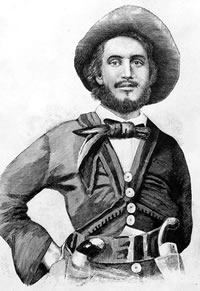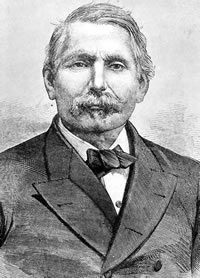Edward Fitzgerald Beale
The most exotic transportation "first" in the Sierra Nevada was the use of camels in the 1850s and 1860s. Much of the history of this colorful camel conveyance revolves around Edward Fitzgerald Beale, one of the most accomplished and largely overlooked figures of the 19th century American West.
Beale was an important national figure. He received appointments and commissions from five United States Presidents beginning with Andrew Jackson and concluding with Ulysses S. Grant. He was a lieutenant in the Navy, an anti-British spy, Mexican War veteran, Superintendent of Indian Affairs for California and Nevada, Surveyor General of California, Brigadier General in the California State Militia, and Ambassador to Austria-Hungary.
He Provided Proof of Gold Discovery
In 1848, Edward Fitzgerald Beale was responsible for providing physical proof to the Federal Government in Washington, D.C. of the gold discovery in California. Carrying a bag of gold samples, his stealthy journey east required Beale to don a disguise while scurrying through Mexican territory. Beale counted among his many friends Kit Carson, John C. Frémont’s scout; the flamboyant showman Buffalo Bill Cody; Civil War hero General William Tecumseh Sherman; and Emperor Franz Josef I of Austria-Hungary.
In 1865-1866, Beale purchased Tejon Ranch, Mexican land grants in California that totaled 270,000 acres—real estate roughly equivalent in size to metropolitan Los Angeles. In 1871, Edward Beale purchased Decatur House, a mansion built in 1818 by American naval hero Stephen Decatur. Across the street from the White House, the residence was rented by the Federal Government for use by several Secretaries of State. Beale Air Force Base near Marysville is named for him.
Send in the Camels
But the most bizarre entry of Beale’s résumé is as the first and only commander of a camel expedition in United States history.
As early as 1836, the United States War Department had toyed with importing camels for use as a means of transport in the arid regions of the country. In 1848, with the California Gold Discovery, the concept of utilizing camels for frontier military service gained momentum. An early supporter was Jefferson Davis, United States Senator from Mississippi. In 1853, Davis became the Secretary of War (a few years later, of course, Jefferson Davis would be the President of the Confederate States of America during the Civil War) and gave his full backing to an experiment with a Camel Corps. In a December 1, 1853 report to President Franklin Pierce, Davis urged government action to import camels:
For military purposes, for expresses, and for reconnaissances, it is believed, the dromedary [camel] would supply a want now seriously felt in our service; and for transportation with troops rapidly moving across the country, the camel, it is believed, would remove an obstacle which now serves greatly to diminish the value of efficiency of our troops on the western frontier.
Congress did not act immediately. Davis again appealed for funding for a test of the animals’ capabilities in western terrain and weather conditions. On March 3, 1855, a bill was passed appropriating $30,000 for a camel experiment. Among those strongly voicing public support was Edward Fitzgerald Beale, then Superintendent of Indian Affairs in California and Nevada. 
Shipping Camels
In late 1855, the store-ship Supply was dispatched to the Middle East to purchase camels. By September 1856, the Supply was loaded with thirty-three single-humped Dromedary camels from Egypt and Tunisia. One creature was so tall that a hole had to be cut in the roof of the cargo bay to allow enough space for the hump. This shipload arrived in Galveston, Texas, on February 10, 1857. The Supply was then ordered to return to Egypt to secure another forty-four camels for the experiment.
All the camels arrived in Camp Verde, Texas, on August 26, 1857. Edward Fitzgerald Beale was chosen to head the expedition. In 1857, Beale had also been tasked by President James Buchanan to survey and construct a 1,000-mile road from New Mexico to California. Beale would extend the California terminus to his property at Fort Tejon, near today’s Bakersfield. Beale used his camels as pack animals during these forays. From all accounts, the camels acquitted themselves admirably—traveling days without water, carrying much heavier loads than horses and mules, and surviving on the available rough forage that other animals would not touch.
In January 1858, to test the camel’s adaptability to cold conditions, Edward F. Beale established a camp high in the southern Sierra. Beale reported in his journal:
The camels … I had placed in camp within a few hundred yards of the summit of the Sierra Nevada, and to this date they had lived in two or three feet of snow, fattening and thriving wonderfully all the while. Lately, in a terrible snowstorm, the wagon, carrying provisions to the camp, could proceed no further. The camels were immediately sent to the rescue, and brought the load through the snow and ice to camp, though the six strong mules of the team were unable to extricate the empty wagon.
Useful But Unsuccessful
Upon reaching California and his home at Fort Tejon, Beale and the War Department assessed the Camel Corps experiment. Most agreed the camels had commendable and useful qualities. Despite intelligence that the camels were not compatible with other animals and scared the soldiers, Beale suggested the experiment continue and, in 1858, the new Secretary of War John B. Floyd recommended the government purchase an additional 1000 camels immediately. Floyd’s request was rejected in 1858, 1859 and 1860, and then the beginning of the Civil War permanently ended the military exercise.
Some of Beale’s camels were auctioned, but Beale kept a few at his Fort Tejon ranch. A small number of the marketed camels became circus performers, a handful were used for racing, but most served as pack animals for private firms. It is likely that some camels were simply released into the Nevada desert. It is fact that wild camels became such a nuisance in Nevada that the State Legislature passed an act in February 1875 prohibiting "camels and dromedaries from running at large on or about the public highways of the State of Nevada." The law was not repealed until 1899.
Image Credits:
- Beale as a Young Man. Source: Collections of the U.S. Naval Historical Center, Department of the Navy, Washington D.C.
- Loading the Camels for Transport to America. Source: United States. War Department. Report of the Secretary of War, Communicating, in Compliance with a Resolution of the Senate of February 2, 1857, Information Respecting the Purchase of Camels for the Purposes of Military Transportation. Washington : A. O. P. Nicholson, printer, 1857. [UC350 .U5 1857]
- Edward Fitzgerald Beale. Source: Collections of the U.S. Naval Historical Center, Department of the Navy, Washington, D.C. Originally in Stephen Bonsal, Edward Fitzgerald Beale: Pioneer in the Path of Empire (New York: G.P. Putnam and Sons, 1912)
